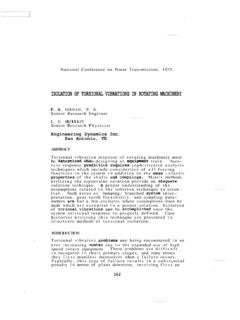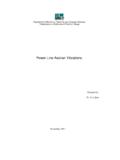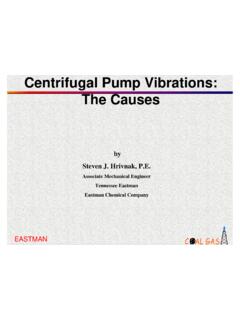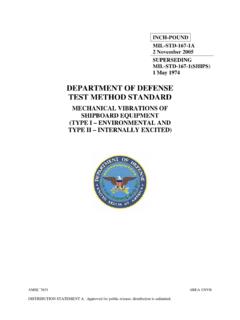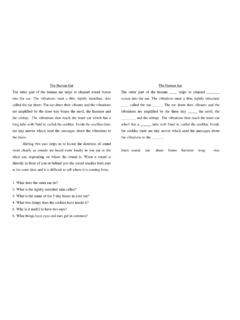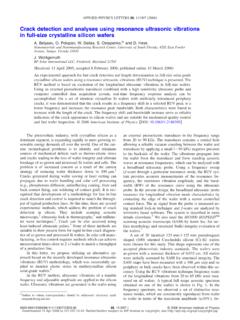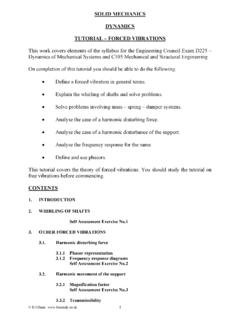Transcription of Stick-Slip Vibrations Induced by Alternate Friction Models
1 Nonlinear Dynamics 16: 41 54, 1998. 1998 Kluwer Academic Publishers. Printed in the Netherlands. Stick-Slip Vibrations Induced by Alternate Friction Models R. I. LEINE, D. H. VAN CAMPEN, and A. DE KRAKER. Department of Mechanical Engineering, Eindhoven University of Technology, Box 513, 5600 MB Eindhoven, The Netherlands L. VAN DEN STEEN. Shell International Exploration and Production , Box 60, 2280 AB Rijswijk, The Netherlands (Received: 12 June 1997; accepted: 8 January 1998). Abstract. In the present paper a simple and efficient Alternate Friction model is presented to simulate Stick-Slip Vibrations . The Alternate Friction model consists of a set of ordinary non-stiff differential equations and has the advantage that the system can be integrated with any standard ODE-solver. Comparison with a smoothing method reveals that the Alternate Friction model is more efficient from a computational point of view.
2 A shooting method for calculating limit cycles, based on the Alternate Friction model, is presented. Time-dependent static Friction is studied as well as application in a system with 2-DOF. Keywords: Stick-Slip Vibrations , shooting method, dry Friction , discontinuous systems. 1. Introduction The presence of Friction - Induced self-sustained Vibrations can be highly detrimental to the performance of mechanical systems. Two general forms of Friction - Induced vibration may be identified, namely, Stick-Slip and quasi-harmonic oscillation [6, 10]. Stick-Slip vibration is characterized by a sawtooth displacement-time evolution which has clearly defined stick and slip phases in which the two surfaces in contact stick respectively slip over each other. The motion is governed by a static Friction force in the stick phase and a velocity dependent kinetic Friction force in the slip phase.
3 On the other hand, quasi-harmonic Friction - Induced vibration has a nearly sinusoidal displacement-time evolution and the motion is initiated and maintained in the slip phase. Quasi-harmonic Friction - Induced vibration is caused by a hump in the Friction -velocity profile [6]. The first step to reduce or avoid these Vibrations is to create a representative numerical model that can be used to evaluate all possible phenomena and can be incorporated in a control system. The study of Stick-Slip Vibrations is faced with difficulties, as during the Stick-Slip motion two different mechanisms take place. The modeling of the static Friction mechanism and that of the kinetic Friction mechanism yield a set of differential equations with discontinuous right-hand side. A standard method to solve discontinuous differential equations consists of applying a smoothing method (also called normalization method).
4 The smoothing method [13, 18, 19, 23] replaces the discontinuous system by a smooth adjoint system. The smoothing method yields a system of ordinary but stiff differential equations and consequently leads to large computational times. 42 R. I. Leine et al. The problems of the smoothing method led to the development of Models which switch between different sets of equations, the so-called Alternate Friction Models ' or switch mod- els'. Many researchers studied Stick-Slip Vibrations with switch Models similar to the switch model of Pfeiffer [14, 18, 21]. The switch model of [17] starts from an initial state with a set of differential equations. After each timestep the state vector is inspected on a possible event within this timestep ( slip to stick transition). If an event happened, the integration process is halted and an iteration procedure is started to find the switching point (within a certain range of accuracy).
5 Having thus evaluated the switching point, a new integration process is started with a modified set of differential equations and initial conditions identical to the state at the switching point. The need to halt the integration process, determine the discontinuity with an iteration process and restart the integration again is undesirable from a numerical point of view. Stan- dard integration methods integrate a set of differential equations over a specified time interval. So, if the integration needs to be halted at the discontinuity, standard integration methods cannot be applied. In the present paper a simple and efficient switch model is presented to simulate Stick-Slip Vibrations . The specific switch model presented here consists of a set of ordinary non-stiff differential equations.
6 This has the advantage that the system can be integrated with any stan- dard ODE-solver available in mathematical packages (MAT L AB, M ATHEMATICA, M APLE). or ODE-solvers of existing software libraries (NAG). The system is thus integrated without the need to halt which minimizes start-up costs. The shooting method as a periodic solution finder in combination with a smoothing method, was applied in [23] to find periodic Stick-Slip solutions. Shooting methods as periodic solution solvers in combination with switch Models have not been addressed in the past. The current paper presents a method to combine shooting with the proposed switch model. A brief introduction on the standard shooting method will be given first. 2. Shooting Method A number of algorithms are available for finding periodic solutions.
7 The shooting method is probably the most popular one [4, 16, 22], and will be discussed in this section. Consider an nth-order, autonomous, nonlinear dynamic system represented by the state equation x = f (x ), (1). e e e where x dx /dt, x is a column with the n state variables of the system, t is time and f is e e e a column of nonlinear functions of the components of x . Since f does not depend on t,ethe e e system is called autonomous, as opposed to non-autonomous systems, where f is a function e of both x and t. In the following, only autonomous systems are dealt with. e In an initial-value problem, the initial condition is usually given at t = t0 . Because f is e independent of t, solutions based at time t0 6 = 0, can always be translated to t0 = 0. Hence, the initial condition reads x (t = 0) = x 0.
8 (2). e e The solution to Equation (1), satisfying (2) is often written as t (x 0 ), to explicitly show the e e dependence on the initial condition in (2). Stick-Slip Vibrations 43. The shooting method finds periodic solutions of the system by solving a two-point bound- ary-value problem, in which solutions are sought of H (x 0 , T ) T (x 0 ) x 0 = 0, (3). e e e e e e where T is the period time of the periodic solution and x 0 is a state on the limit cycle. Since e Equation (3) is a system of n equations in n +1 unknowns (the n components of x 0 and period e T ), it cannot be solved directly. Instead, y H (x 0 , T ) is linearized, to obtain e e e H H. 1y e 1x 0 + e 1T = (8 T (x 0 ) I )1x 0 + f ( T (x ))1T , (4). e x 0 e T e e e e e e where the matrix 8 T (x 0 ) results from the variational equation (see Appendix A).
9 To achieve e H 0, 1x 0 and 1T will be chosen in such a way that 1y = H . This value of 1y is e e e e e e inserted into Equation (4), giving H = (8 T (x 0 ) I )1x 0 + f ( T (x 0 ))1T . (5). e e e e e e To make this system solvable, a constraint is added, which restricts the state correction term 1x 0 to be orthogonal to f , given by e e f (x 0 )T 1x 0 = 0. (6). e e e From Equations (5) and (6), the following iterative scheme is assembled, with which zeros of H can be found, using initial guesses x (0) and T (0). e e0. " #" # " (i) #. 8 T (i) (x (i). 0 ) I f ( T (i) (x (i). 0 )) 1x (i) x 0 T (i) (x (i) ). e e e e e 0. = e e e 0. , (7). f (x (i). 0 ) T. 0 1T (i). 0. e e " (i+1) # " (i) # " #. x0 x0 1x (i). e = e (i) + e0 . (8). T (i+1) T 1T (i). The superscripts have been added to indicate the iteration count.
10 This scheme is reiterated, until some convergence criterion is met. There is a clear similarity to the Newton Raphson al- gorithm, so the same convergence properties apply. When the shooting method returns values x 0 and T , it should be tested, whether T is the minimum period of the solution, since it could e be a multiple of the actual period. Only single shooting is considered in this paper for reasons of simplicity. 3. Single-Degree-of-Freedom Model A single-degree-of-freedom model will be used to introduce and evaluate the numerical methods described in this paper. The same model treated in [7, 23] is used to facilitate the comparison of results. Consider a mass m attached to inertial space by a spring k, where m = 1 [kg] and k = 1 [N/m]. The mass is riding on a driving belt, that is moving at constant velocity vdr = [m/s] (Figure 1).

